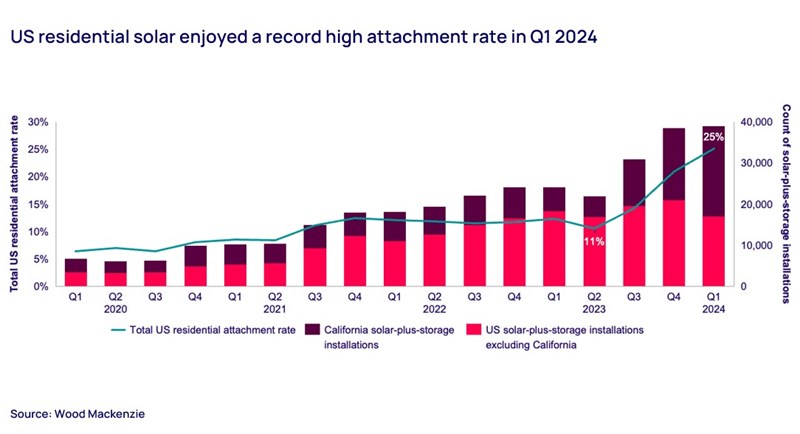The state of US distributed solar-plus-storage
Attachment rates are booming for residential installations, but the non-residential segment has been slower to adopt batteries
3 minute read
Max Issokson
Research Analyst, US Distributed Solar

Max Issokson
Research Analyst, US Distributed Solar
Max supports research and data collection for our US Distributed Solar practice.
Latest articles by Max
-
Opinion
Tracking distributed solar and storage competitive landscapes
-
Opinion
RE+ 2024: Our 7 biggest takeaways
-
Opinion
The state of US distributed solar-plus-storage
-
Opinion
US distributed solar and storage competitive landscapes shift in 2023
-
Opinion
Which installers and battery vendors top the US distributed solar-plus-storage leaderboard?
-
Opinion
Distributed solar-plus-storage holds much promise, but where does it stand today?
Pairing solar with battery storage provides a key solution to intermittency which has long been an Achilles heel for solar power. So, is solar-plus-storage taking off as an effective, future-proof solution to supplying US homes and workplaces with electricity?
At our recent Solar & Energy Storage Summit 2024 in San Francisco, we delivered an in-depth assessment of the current state of the US distributed solar-plus-storage market. Fill out the form at the top of the page to download an extract of our presentation from the Summit, and read on for a summary of the key takeaways.
Residential solar-plus-storage is gaining momentum in the US
One way we evaluate the solar-plus-storage industry is by looking at attachment rates, or the share of solar projects installed with batteries. The US total residential attachment rate is in the midst of an exciting climb. The attachment rate has quadrupled since Q1 2020, growing from 6% in Q1 2020 to 25% in Q1 2024 (see chart below). State-level storage incentives, demand for backup power, falling battery prices, and solar incentive rate reform have all contributed to this growth.
The largest driver of attachment rate growth in the last few quarters has been California's new distributed solar compensation policy, the Net Billing Tariff (NBT). NBT has been effective in incentivizing solar-plus-storage as the policy reduces the value of excess solar energy exported to the grid. Homeowners are now incentivised to install batteries to maximize solar self-consumption. Solar-plus-storage installations averaged over 5,000 per month in Q1 2024 compared to 2,000 per month in 2022. We expect solar-plus-storage to continue to grow in the state even as the residential solar market contracts.
While attachment rates are rising around the county, the solar-plus-storage market is heavily concentrated in a few key markets. Notably, California and Puerto Rico solar-plus-storage markets dwarf other states’ by number of installations. In 2023, these states accounted for nearly three-quarters of all installations.
We expect US residential solar-plus-storage installations to more than double year-on-year from 2023 to 2024, hitting 181,000. The number of annual installations will continue to grow through to 2028, albeit at a progressively slower rate. Overall attachment rates will remain above 25% for most of this period.
The non-residential segment has been slower to adopt storage
In comparison with residential solar, the US non-residential solar segment has been slower to adopt storage, with attachment rates failing to go much above 5% to date. The markets with the most non-residential solar-plus-storage capacity feature direct storage incentives that encourage developers to pair storage with larger community solar and, or, commercial solar projects. These markets include California, Massachusetts, and New York. Where incentives are unavailable, the desire for backup power and demand charge management spurs adoption. But demand in these unincentivized markets is spottier, reliant on individual customer needs.
Both residential and non-residential solar-plus-storage installer markets are more concentrated than solar
US residential solar installation is a highly competitive segment, with the top seven installers accounting for only a quarter of total market share. By comparison, the solar-plus-storage market is more concentrated, with the top two companies, Tesla Energy and Sunrun, accounting for nearly 50% of the market. The next four largest installers in order are SunPower, Titan Solar Power, Freedom Forever and Semper Solaris, between them accounting for a further 13%.
Like the residential segment, non-residential solar-plus-storage in the US is more concentrated than the market for non-residential solar alone. The top six solar installers captured a market share of just 16% in 2023, whereas the top six solar-plus-storage installers enjoyed more than 50% of the market.
Market leader Tesla faces growing competition to supply batteries for distributed solar-plus-storage
Historically, Tesla Energy has dominated the residential solar-plus-storage battery space, but it faces increasing competition from other battery manufacturers. Together, Enphase, SolarEdge, LG, SunPower, FranklinWH, Qcells and Sonnen took nearly 60% of the total market in Q1 2024, with Tesla supplying most of the remainder.
Meanwhile, the battery supplier market for non-residential solar-plus-storage installations is even more fragmented. Our calculations show that the top eight manufacturers supplied batteries to 77% of installations in Massachusetts and New York rated at over 500 kWdc between 2020 and 2023, with the remaining 23% accounted for by a range of other suppliers.
Learn more
Don’t forget to fill out the form to download the full presentation, which covers these themes in detail and includes a range of charts and supporting data.







